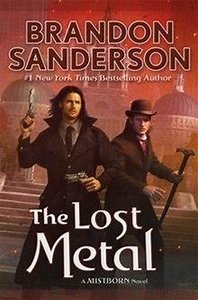The Lost Metal by Brandon Sanderson is the fourth installment in the Mistborn: Wax and Wayne series, situated in the same world as the original Mistborn trilogy. The narrative follows Waxillium “Wax” Ladrian, a lawman endowed with the ability to manipulate metal objects through pushing and pulling, alongside his partner, Wayne, who possesses the power to alter his appearance. The central plot revolves around their pursuit of a dangerous and enigmatic conspiracy that threatens both the government and the stability of the world.
As Wax grapples with the dual burdens of his noble heritage and his duties as a lawman, he confronts a series of personal and external challenges. Among these is the emergence of a formidable new faction determined to disrupt the existing peace. The novel delves into themes of loyalty, identity, and sacrifice, offering a rich exploration of complex character dynamics, political intrigue, and intense action. Through a combination of mystery, fantasy, and adventure, the book steadily builds toward a climax that unveils long-hidden truths regarding the world’s past and its future trajectory.

The Lost Metal by Brandon Sanderson is the eagerly awaited fourth installment in the Mistborn: Wax and Wayne series, set within the expansive Cosmere universe. Following the events of The Alloy of Law, Shadows of Self, and The Bands of Mourning, the novel continues the story of Waxillium “Wax” Ladrian, a nobleman-turned-lawman endowed with the power to manipulate metals through Allomancy and Feruchemy. Accompanying him is his ever-loyal partner, Wayne, a shape-shifter with a sharp wit and a talent for deception.
The narrative unfolds in a world transitioning from medieval society to rapid industrialization, with technology advancing at an unprecedented pace, while magic systems evolve alongside it. Wax remains conflicted by his dual identity as both a nobleman and a lawman, and the story explores his internal struggle as he seeks to balance his duties with his personal desires. As the head of House Ladrian, a noble family, Wax finds himself increasingly caught between his sense of justice and the political maneuvering that surrounds him.
The plot centers on the discovery of a powerful artifact—the lost metal—that holds the potential to reshape the world. This discovery is linked to an emerging conspiracy surrounding the control of the industrial revolution, with shadowy figures and hidden agendas lurking beneath the surface. As Wax and Wayne delve deeper into the mystery, they face a rising threat that could destabilize the entire world. Along the way, they encounter a new, dangerous enemy—a faction determined to harness the power of the lost metal for their own gain. Wax’s sense of duty is put to the test, especially as his relationships with friends and family grow more complicated.
The novel examines themes of loyalty, identity, and sacrifice, with Wax’s evolution as a central focus. He reflects on his place in a rapidly changing world, confronting difficult questions about the kind of man he aspires to be. Wayne, ever the steadfast companion, offers both comic relief and a contrasting perspective, often providing levity amid the story’s intense moments. As the characters uncover secrets about the lost metal, they discover that its significance extends far beyond their personal fates, influencing the future of the world itself. Wax’s leadership is challenged as shifting alliances and encroaching enemies put both him and his loved ones in jeopardy.
The Lost Metal also provides vital insights into the broader history of the Cosmere and Brandon Sanderson’s interconnected universe. The conclusion brings resolution to several ongoing storylines, while leaving the door open for future installments, as the characters’ journeys evolve within the larger context of the universe’s unfolding events. The book culminates in a thrilling and emotional climax, tying up long-standing mysteries while teasing upcoming conflicts and adventures.
Blending high-stakes action, political intrigue, and deep, character-driven storytelling, The Lost Metal delivers the compelling narrative that fans of Sanderson’s work have come to expect. While it retains familiar elements from the Mistborn series, the novel also broadens the scope of its world-building and magic systems, adding layers of complexity that make it an essential read for devotees of the Cosmere universe.
The Lost Metal by Brandon Sanderson was officially published on November 15, 2022, by Tor Books. It serves as the fourth and final installment in the Mistborn: Wax and Wayne series, part of Sanderson’s expansive Cosmere universe. The novel picks up where its predecessors left off, following the continued adventures of Waxillium “Wax” Ladrian and his partner, Wayne, as they uncover a perilous conspiracy involving a powerful artifact. The book’s release was highly anticipated, fueled by the widespread popularity of the Mistborn series and Sanderson’s reputation for producing complex, immersive narratives. It was written during a particularly productive period for the author, who was working on several projects concurrently.
The launch of The Lost Metal was supported by a comprehensive marketing campaign, which included pre-order incentives and special edition releases. Fans eagerly awaited the novel, drawn by Sanderson’s renowned skill in world-building, his deep character development, and his ability to craft satisfying resolutions to intricate story arcs. In addition to its traditional print and e-book formats, the novel was also made available in audiobook format, narrated by Michael Kramer and Kate Reading, who have long been collaborators with Sanderson.
Upon its release, The Lost Metal garnered generally positive reviews from both critics and readers. Many praised the book for its action-packed plot, detailed world-building, and emotional depth, particularly as it brought resolution to long-standing character arcs and mysteries within the Mistborn series. Fans expressed satisfaction with the conclusion of Wax and Wayne’s journey, noting the book’s effective blend of character-driven moments and high-stakes action. However, some readers observed that certain elements of the plot might feel familiar or predictable, especially considering the expansive nature of Sanderson’s prior works. Despite these critiques, the reception of The Lost Metal reaffirmed Sanderson’s position as a leading figure in modern fantasy literature and further solidified the Mistborn series as an integral part of the broader Cosmere universe.







